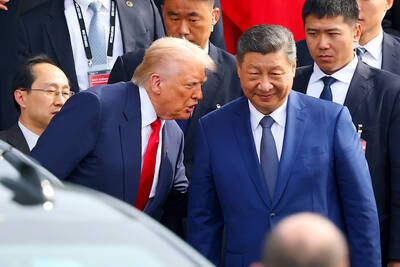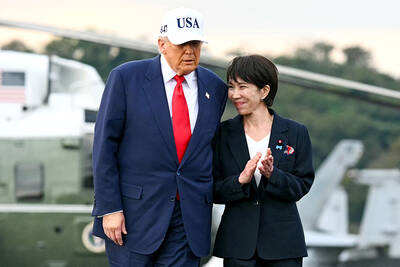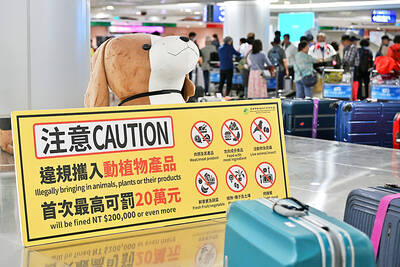Senior Ministry of National Defense officials and other experts said enhanced cooperation arising from the formation of military “sister units” between Taiwan and the US could help counter a possible marine blockade and attack by China’s People’s Liberation Army.
Taiwan’s Aviation Special Forces 601st Brigade, based in Taoyuan, has formed a sister-unit relationship with the Hawaii-based US Army 25th Combat Aviation Brigade, according to a report by the Liberty Times (the sister newspaper of the Taipei Times).
The 25th is a unit of the US 25th Infantry Division of the US Pacific Command, headquartered in Hawaii for military operations in the Asia-Pacific region.

Photo courtesy of the Army Command Headquarters
The Psychological Warfare Battalion Headquarters of the ministry’s Political Warfare Brigade has also formed a sister-unit relationship with the US 7th Psychological Operations Group, which is also part of the US Pacific Command, the report said.
A senior military official was quoted in the report as saying that the US initiated the two military cooperation programs.
The arrangement was made partially because Taiwan’s 601st Brigade was modeled on US Army combat aviation units, using Apache AH-64 attack helicopters, OH-58D Kiowa reconnaissance helicopters and Black Hawk UH-60 utility helicopters, the report said.
Ministry Administrative Deputy Minister Lieutenant General Wang Shin-lung (王信龍) on Wednesday confirmed the development when he responded to questions at a meeting of the Foreign Affairs and National Defense Committee at the legislature in Taipei.
Forming sister units has both symbolic and practical meaning, Wang said.
He did not provide details on the scope of the collaboration.
Ministry spokesperson Major General David Lo (羅紹和) also confirmed the developments, saying: “The defense ministry welcomes the arrangement, since these exchanges can boost the capability of our armed forces.”
He also declined to elaborate on details of the collaborations.
DPP Legislator Tsai Huang-liang (蔡煌瑯) and defense experts said the development communicated a clear political message of an improving relationship between Taiwan and the US, while warning China against any military intentions in the Asia-Pacific region.
“Although the Ministry of National Defense would talk only about the ‘military exchange’ aspect, it is in effect the US’ way of including Taiwan in its military alliance in the region,” Tsai said yesterday. “We see that the US is implementing its strategy with a pivot toward the Asia-Pacific region and US forces are returning to this part of the world in a big way. So this is a very crucial time and Taiwanese must seize this opportunity to enter into a military alliance with US.”
Tsai said it also shows that Washington understands Taiwan’s important and strategic position in the face of China’s growing military strength and potential conflicts over disputed territorial claims.

UKRAINE, NVIDIA: The US leader said the subject of Russia’s war had come up ‘very strongly,’ while Jenson Huang was hoping that the conversation was good Chinese President Xi Jinping (習近平) and US President Donald Trump had differing takes following their meeting in Busan, South Korea, yesterday. Xi said that the two sides should complete follow-up work as soon as possible to deliver tangible results that would provide “peace of mind” to China, the US and the rest of the world, while Trump hailed the “great success” of the talks. The two discussed trade, including a deal to reduce tariffs slapped on China for its role in the fentanyl trade, as well as cooperation in ending the war in Ukraine, among other issues, but they did not mention

Japanese Prime Minister Sanae Takaichi yesterday lavished US President Donald Trump with praise and vows of a “golden age” of ties on his visit to Tokyo, before inking a deal with Washington aimed at securing critical minerals. Takaichi — Japan’s first female prime minister — pulled out all the stops for Trump in her opening test on the international stage and even announced that she would nominate him for a Nobel Peace Prize, the White House said. Trump has become increasingly focused on the Nobel since his return to power in January and claims to have ended several conflicts around the world,

REASSURANCE: The US said Taiwan’s interests would not be harmed during the talk and that it remains steadfast in its support for the nation, the foreign minister said US President Donald Trump on Friday said he would bring up Taiwan with Chinese President Xi Jinping (習近平) during a meeting on the sidelines of the APEC Summit in South Korea this week. “I will be talking about Taiwan [with Xi],” Trump told reporters before he departed for his trip to Asia, adding that he had “a lot of respect for Taiwan.” “We have a lot to talk about with President Xi, and he has a lot to talk about with us. I think we’ll have a good meeting,” Trump said. Taiwan has long been a contentious issue between the US and China.

Taiwan’s first African swine fever (ASF) case has been confirmed and would soon be reported to the World Organization for Animal Health (WOAH), Minister of Agriculture Chen Junne-jih (陳駿季) yesterday. The Ministry of Agriculture’s Veterinary Research Institute yesterday completed the analysis of samples collected on Tuesday from dead pigs at a hog farm in Taichung and found they were ASF-positive. Animal and Plant Health Inspection Agency Animal Quarantine Division chief Lin Nien-nung (林念農) said the result would be reported to the WOAH and Taiwan’s major trade partners would also be notified, adding that pork exports would be suspended. As of Friday, all samples